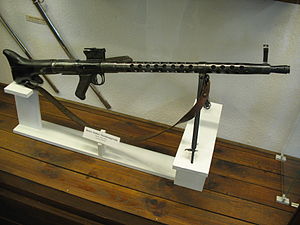This article needs additional citations for verification. (September 2014) |
| MG 30 | |
|---|---|
 The MG 30 on display in Austria. (Festung Hohensalzburg) | |
| Type | Light machine gun |
| Place of origin | Switzerland/Austria |
| Service history | |
| In service | 1930s–1940s |
| Used by | See Users |
| Wars | World War II |
| Production history | |
| Designer | Louis Schmeisser |
| Manufacturer | Steyr-Werke AG FÉG |
| Produced | 1931-1945 |
| No. built | more than 15000 |
| Variants | MG 15 MG 17 ( Both used in aircraft) |
| Specifications | |
| Mass | 7.92x57mm: 9.5 kg (21 lb) 8x56R: 8.4 kg (19 lb) |
| Length | 1,162 mm (45.7 in) |
| Barrel length | 600 mm (24 in) |
| Cartridge | 7.92×57mm Mauser 8×56mmR 7×57mm Mauser |
| Action | Recoil |
| Rate of fire | 550—600 RPM (practical: 100RPM) |
| Muzzle velocity | 807.92 m/s (2,650 ft/s) |
| Effective firing range | 800 m |
| Feed system | 30-Round magazine (7.92x57mm) 25-Round magazine (8×56mmR) |
The Maschinengewehr 30, or MG 30 was a German-designed machine gun that saw some service with various armed forces in the 1930s.[1] It was also modified to become the standard German aircraft gun as the MG 15 and MG 17. It is most notable as the design pattern that led to the MG 34 and MG 42, and thus is one of the major ancestors of many of the weapons in service which would later find widespread use into the 21st century.